Arthur Hayes: The crypto bull market will arrive with the increase in U.S. dollar liquidity
Original Title: Bad Gurl
Original Author: Arthur Hayes
Original Compiler: Kate, Mars Finance
Editor's Note: Arthur Hayes, co-founder and former CEO of BitMEX, has published a new article titled "Bad Gurl," introducing U.S. Treasury Secretary Janet Yellen and how her plans will drive the BTC bull market, where Janet Yellen is described as the "Bad Gurl." The "Bad Gurl" symbolizes participants in trading and investment who use unconventional, aggressive, or innovative methods, willing to take high risks and employ aggressive strategies to gain profits, whose actions can significantly influence market trends and volatility, often causing major market fluctuations. The "Bad Gurl" may utilize various strategies and tactics, including rapid trading and speculative investments. Currently, there is volatility in the market and certain market patterns, and the "Bad Gurl" can influence these trends, thereby strengthening and stabilizing market conditions. With the rapid development of the cryptocurrency market, investors and market observers are increasingly focused on the financial trends in this field. In this article, Arthur Hayes provides an in-depth analysis of the latest dynamics in the crypto market and the key factors influencing its trends, including policy regulation, technological innovation, and the behavior of market participants. Furthermore, the article emphasizes the risks and challenges in the cryptocurrency market. While cryptocurrencies offer new investment opportunities for investors, their volatility and uncertainty also expose investors to higher risks. Therefore, investors need to fully understand market conditions, develop appropriate investment strategies, and pay attention to changes in policy regulation before entering the crypto market. Arthur Hayes provides readers with a comprehensive analysis of the financial trends in the crypto market, helping people better understand the latest dynamics and development trends in this field.
Bad girl, sad girl, you're such a dirty bad girl
Beep beep, uh-huh
You bad girl, you sad girl, you're such a dirty bad girl
Beep beep, uh-huh
-- Donna Summer
The world's worst woman might be the true number two in American peace, looking like a scruffy dwarf. She no longer dances, perhaps never will again; she makes the money move. I'm talking about U.S. Treasury Secretary Janet Yellen.
Bad girl Yellen, if she wants, can unilaterally exclude individuals, companies, or entire countries from the dollar's global financial system. Given that for most people, having dollars to purchase primary energy (oil and gas) and food is essential, being removed from the U.S.-led peaceful financial system is tantamount to a death sentence. She calls it sanctions; some call it a death sentence.
From a financial perspective, she is responsible for managing the regulations on how the dirty fiat financial system operates. Since credit makes the world go round, and this credit comes from banks and other financial companies, her will has a significant impact on the global economic structure.
Her most important duty is to ensure the U.S. government is funded. When U.S. government spending exceeds tax revenue, she is called upon to issue debt wisely. Given the recent massive scale of the U.S. government deficit, her role becomes even more critical.
But in the world of bad girl Yellen, not everything is good. Her child's father, President Slow Joe, is in arrears on child support. Slow Joe doesn't squander his paycheck on booze and strippers like a typical deadbeat dad. Slow Joe is addicted to spending, blowing up distant countries in pursuit of… who knows what. He has never seen a conflict that the imperial war machine shouldn't support. Fighting a proxy war against the "evil" dictator Putin in Ukraine and the world's largest commodity exporter? Let's fucking go! Supporting Bombardier Bibi Netanyahu in flattening Gaza, displacing millions, and killing tens of thousands of Palestinians, even if such support could lead to war with the Persians? That's America for you!
Our boss Yellen publicly supports her boss, but privately, she is busy ensuring that this empire can issue bonds at affordable prices to feed the children. Who are the children? The baby boomers are aging, getting sick, and requiring more and more healthcare products and other benefits. The military-industrial complex needs an ever-expanding defense budget to produce more bullets and bombs. Interest must be paid to wealthy savers to fulfill commitments to debt holders.
Yellen may be a bad woman, but the market isn't buying it. Long-term Treasury yields (maturity > 10 years) are rising faster than short-term Treasury yields (maturity < 2 years). This presents a fatal problem for the financial system, known as "bear steepening." I wrote in my previous article the Periphery about why this is so harmful to the banking system.
What can she do to get her baby daddy to return to the welfare office in November 2024 to reapply for benefits? She needs to design a solution to buy time for the economy. So, here is the task list for bad girl Yellen:
Inject liquidity into the system to drive up stock prices. When the stock market rises, capital gains taxes increase, helping to pay some bills.
Deceive the market into believing the Fed will cut rates, thereby alleviating the selling pressure on non-"too big to fail" (TBTF) bank stocks, which are all insolvent.
Create the illusion that the Fed will cut rates, generating demand for long-term debt.
Ensure that the injected liquidity is not too large to avoid skyrocketing oil prices due to a weakening dollar.
The Fed maintained interest rates at its recent meeting and indicated it would further pause rate hikes as it continues to assess the impact of the rate hikes so far. Meanwhile, Yellen stated that the U.S. Treasury would increase the issuance of short-term bills, which is exactly what money market funds (MMF) want. MMFs will continue to withdraw funds from the Fed's reverse repo program (RRP) and purchase Treasury bonds, injecting net liquidity into the market.
The remainder of this article will focus on elaborating my views, explaining why I believe the above policies will lead to the following outcomes:
- Inject $1 trillion of net liquidity into the global financial markets, equivalent to the current size of the RRP.
(A) This liquidity injection will drive up U.S. stocks, cryptocurrencies, gold, and other fixed-supply financial assets.
(B) All other major central banks, such as the People's Bank of China (PBOC), Bank of Japan (BOJ), and European Central Bank (ECB), will also print money, as the U.S. monetary environment is now easing, allowing them to print without weakening their own currencies.
- The market believes that the U.S. Treasury yield curve will steepen in a bull market.
(A) It will prevent the market from selling off all non-TBTF bank stocks.
- Once the RRP is exhausted by the end of 2024, the doomsday for the U.S. Treasury market will play out again.
"Duck" and Coward
Fed Chair Powell is a "duck," and his wife is bad girl Yellen. You might think "duck" is a humble position, but in Hong Kong, "ducks" live a life of luxury and wealth. Many say Powell is a millionaire. But all the money in the world can't change the fact that he is at most Yellen's "towel boy."
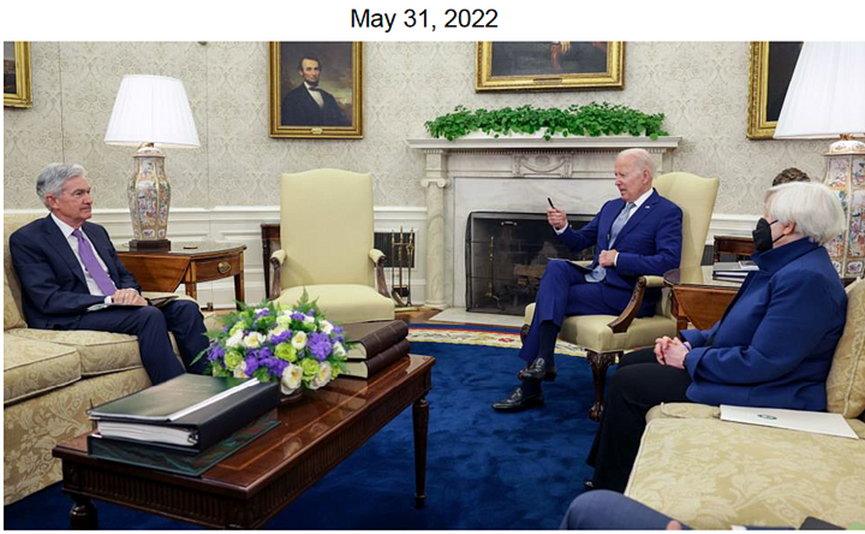
This is one of the most important images to understand the power dynamics at the top of the empire. Slow Joe and Yellen instruct "Duck Powell" to fight inflation at all costs.
The problem with raising interest rates to levels that restrict the economy is that it will destroy the banking system. Therefore, the Fed is playing a game; it pretends to combat inflation while always looking for a way to justify pausing its monetary tightening plan. The simplest (and least honest) way to achieve this is to fabricate misleading statistics about inflation levels.
The government-reported inflation data is all nonsense. It downplays inflation, making the public believe their eyes are deceiving them at the checkout, which serves the government's interests. When you buy a loaf of bread, the price shock you feel is not credible because the government tells you inflation doesn't exist at all. To do this, bureaucrats create these representative baskets of goods to lessen the impact of rising food and energy prices. Misleading inflation statistics are calculated based on the price changes of this basket of currencies.
The Fed doesn't like high consumer price index (CPI) readings, which include food to fill bellies and gasoline to fuel vehicles, so they do some fancy calculations. Miraculously, this leads to the creation of core CPI, or what they like to call "core inflation." Core CPI excludes food and energy. But core CPI is too high, so the Fed asks staff to remove non-transitory factors from core CPI to get a better (i.e., lower) inflation measure. After doing more magical math, they create a multi-core trend indicator.
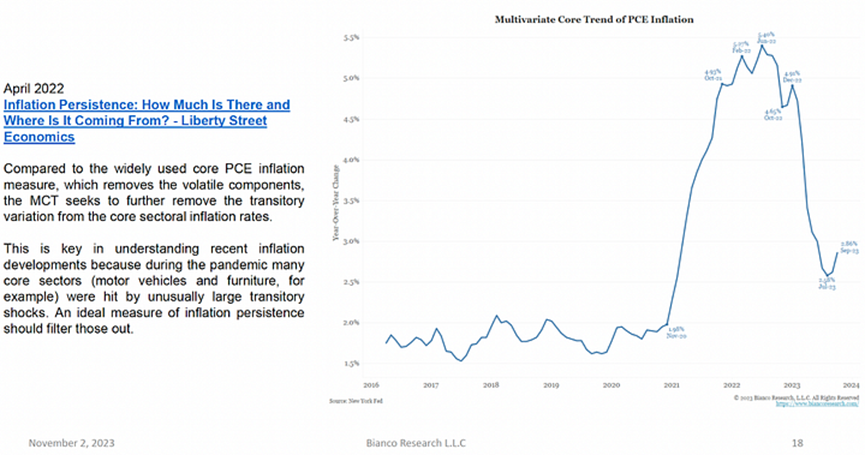
The problem is that all these manipulated inflation indicators are above the Fed's 2% target. Worse still, these indicators seem to have bottomed out. If the Fed were truly combating inflation, they should continue to raise rates until their fuzzy inflation indicators reach 2%. But suddenly, Powell stated at the September press conference that the Fed would pause rate hikes to observe the effects of its rate hikes.
My suspicion is that Powell received a little nudge from Yellen and was told that mommy wants him to pause again and signal to the market that the Fed will pause rate hikes until further notice. This is a clever policy response, in my view.
The market is willing to believe that a recession will come next year. A recession means the Fed must cut rates to ensure that terrible deflation does not occur. Deflation is the result of declining economic activity leading to falling prices. Deflation is harmful to the dirty fiat system because the value of the assets (collateral) supporting the debt decreases. This causes losses for creditors (i.e., banks and the wealthy). Therefore, the Fed cuts rates.
As I explained in my previous article, due to weakening economic forecasts, the market will buy long-term U.S. Treasuries in large quantities. This, combined with the general decline in interest rates caused by Fed policy, means that long-term debt holders will profit. The result is that the yield curve will ultimately steepen.
The market will act first, buying more long-term bonds rather than short-term bonds. This is because when interest rates fall, long-term bonds are more profitable than short-term bonds. What happens next? Bear steepening stops, the curve becomes more inverted, and then when the recession hits in 2024, the bull curve steepens. The Fed achieved all this simply by pausing twice in September and November meetings and providing a forward-looking negative outlook on the economic outlook. This is a victory for Powell and Yellen, as positive market reactions can be achieved without needing to cut rates.
I will illustrate this process with a few simple charts. The longer the arrows, the greater the magnitude.
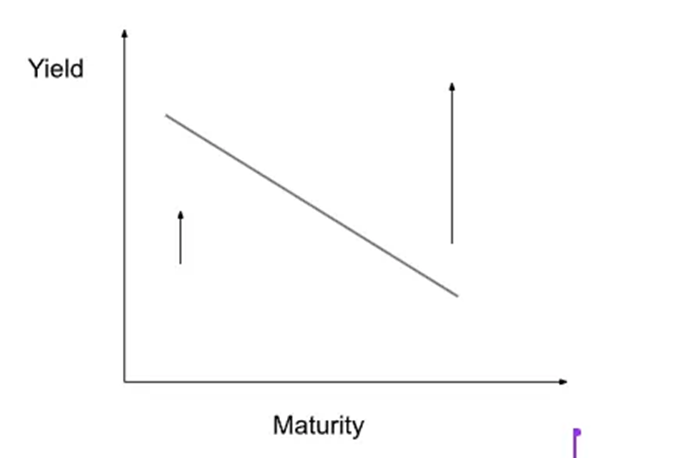
Figure 1: This is the curve of bear steepening. The curve begins to invert, and the yields across the curve rise, with long-term rates rising faster than short-term rates.
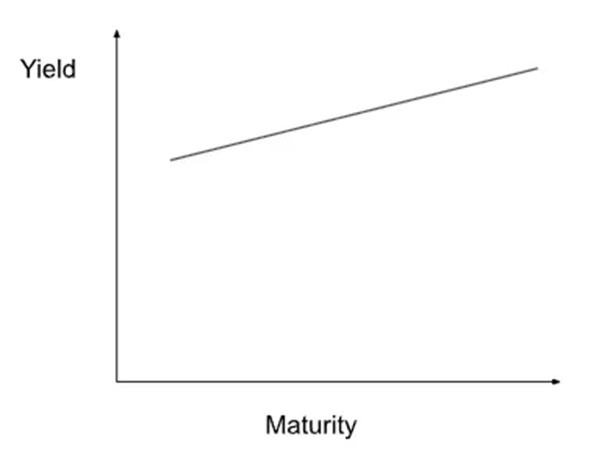
Figure 2: This is the final yield curve. As bear steepening intensifies, at higher rates, you get a positively sloped yield curve. This could be the worst outcome for bondholders and the banking system. Bad girl Yellen must do everything she can to prevent this from happening.
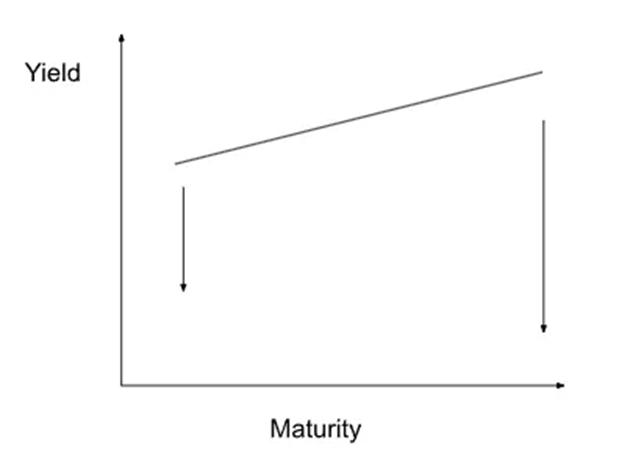
Figure 3: If Yellen's strategy succeeds, and the market buys more long-term bonds than short-term bonds, the curve will re-invert.
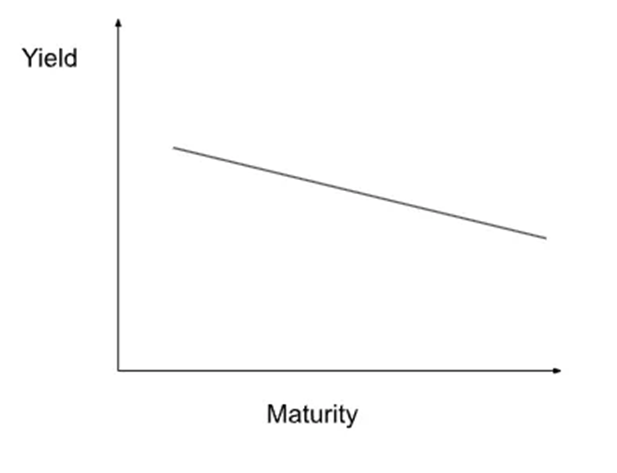
Figure 4: This is the final yield curve. The curve inverts again, which is unnatural. The market expects a recession, which is why long-end yields are lower than short-end yields.
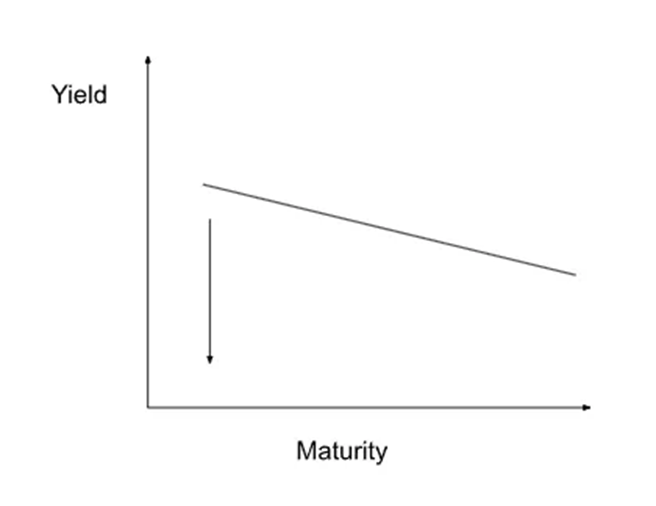
Figure 5: A recession arrives, or some TradFi companies go bankrupt, the Fed cuts rates, leading to a decline in short-term rates while long-term rates remain unchanged. This will steepen the curve.
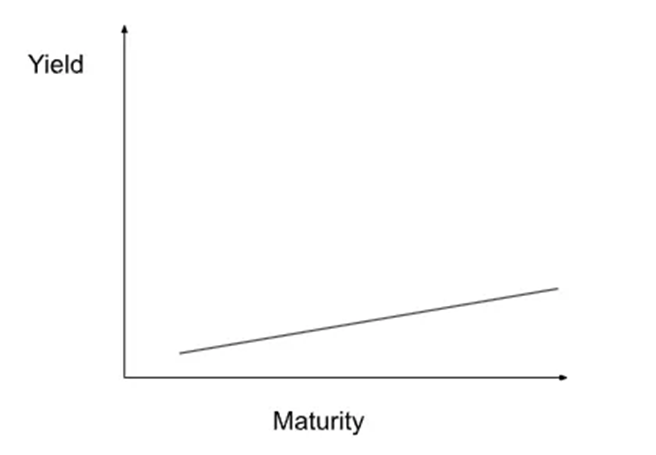
Figure 6: This is the final yield curve. After all these shifts, the curve becomes steeper. The curve is positively sloped, which is natural, and the overall interest rate level has decreased. This is potentially the best scenario for bondholders and the banking system.
Banks Saved
The direct impact of the yield curve inverting again and ultimately steepening in a bull market is that unrealized losses on U.S. Treasuries held to maturity on bank balance sheets decrease.
Bank of America (BAC) reported unrealized losses of $132 billion in the HTM asset class for Q3 2023. BAC's Tier 1 common equity capital is $194 billion, with total risk-weighted assets (RWA) of $1.632 trillion. When you recalculate BAC's capital adequacy ratio (equity / RWA) by subtracting unrealized losses from equity, it drops to 3.8%, far below the regulatory minimum requirement. If these losses are confirmed, BAC will enter bankruptcy proceedings like Silicon Valley Bank, Signature Bank, and First Republic. The higher the long-term Treasury yields, the larger the gap. Clearly, this is untenable. There is one rule for them and another for us.
The banking system is being suffocated by all the government debt it accumulated at record high prices and low yields from 2020 to 2022. Designated as TBTF, BAC is effectively a state-owned bank. However, the rest of the non-TBTF U.S. banking system is insolvent due to unrealized losses on Treasuries and commercial real estate loans.
If Yellen can design a policy that leads to rising bond prices and falling yields, then holders of bank stocks have no reason to sell. This portends an inevitable future: the entire balance sheet of the U.S. banking system will end up on the U.S. Treasury's books. This would be extremely bad news for the credibility of the U.S. government, as the government would have to print money to ensure banks can honor deposit withdrawals. In this scenario, no one would want to buy long-term U.S. Treasuries.
Are There Consequences?
The challenge is that if the Fed cuts rates, the dollar may depreciate significantly. This would put tremendous upward pressure on oil prices, as oil is priced in dollars. While mainstream financial media and cheerleaders like Paul Krugman try to deceive the public into believing inflation doesn't exist, any seasoned politician knows that if gas prices rise on election day, you're done for. That's why, at this critical moment—when the Middle East is on the brink of war—cutting rates is akin to political suicide. By next election day, oil prices are likely to be close to $200.
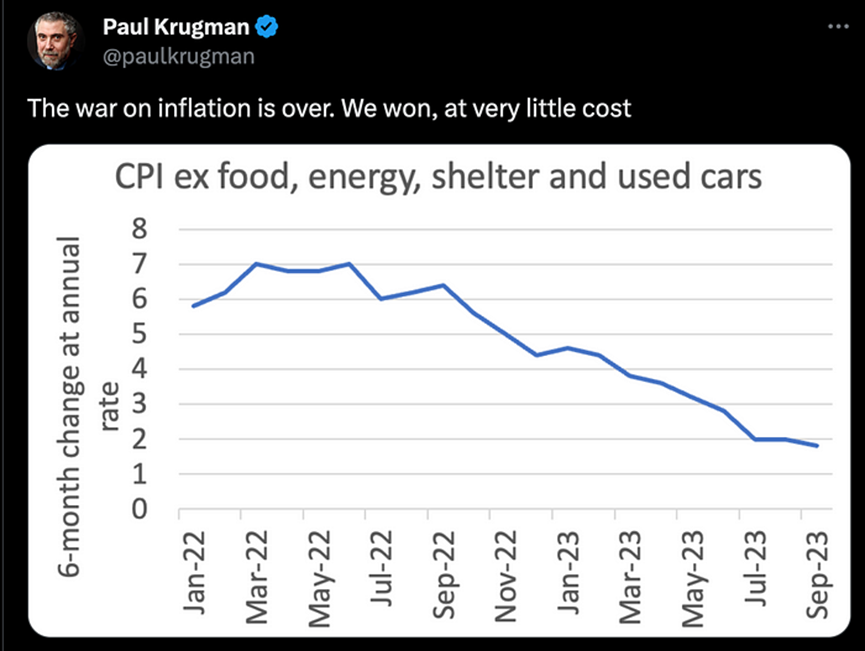
Of course, if you exclude everything people need to live and make a living, inflation doesn't exist.
But what if inflation has already bottomed out, and the Fed pauses rate hikes while inflation accelerates? This is a possible outcome, but I believe any discontent arising from rising inflation will be drowned out by a strong U.S. economy.
Strong Economy
I don't believe there will be a recession in 2024. To understand why, let's return to the primary principles driving GDP growth.
GDP Growth = Private Sector Spending (net exports, investment also included) + Government Net Spending
Government Net Spending = Government Spending - Tax Revenue
When the government engages in deficit net spending, it drives net growth in GDP. This conceptually makes sense—government spends money on things and pays employees. However, the government extracts resources from the economy through taxation. Therefore, if government spending exceeds tax revenue, it provides a net stimulus to the economy.
If the government runs a massive deficit, it means nominal GDP will grow unless the private sector contracts by an equal amount. Government spending— or any spending for that matter—has a multiplier effect. Let's illustrate this with an example from Slow Joe's recent speech to the American public regarding various conflicts involving the empire.
The U.S. government will increase defense spending. Many Americans will manufacture bullets and bombs to kill all the terrorists and more civilians around the empire. As long as no more than 10 civilians are killed for each terrorist, I have no problem with that. It's a "fair" ratio. Those Americans will spend their hard-earned money in their communities. There will be office buildings, restaurants, bars, etc., all built for the workers of the defense industry. This is the multiplier effect of government spending, as it encourages activity in the private sector.
Given this, it is hard to imagine the private sector contracting enough to offset the net gains in GDP growth contributed by the government. In the latest Q3 2023 data dump, U.S. nominal GDP grew by 6.3%, with an annual deficit approaching 8%. If the CPI inflation rate is below 6.3%, then everyone is a winner because real GDP growth is positive. Why would voters be uneasy about this? Given that the CPI inflation rate is at 3, it will take several quarters for inflation to exceed the level of the U.S. economy in the minds of voters.
The deficit for 2024 is expected to be between 7% and 10%. Driven by a spendthrift government, the U.S. economy will perform well. Therefore, moderate voters will be quite satisfied with rising stock markets, a strong economy, and subdued inflation.
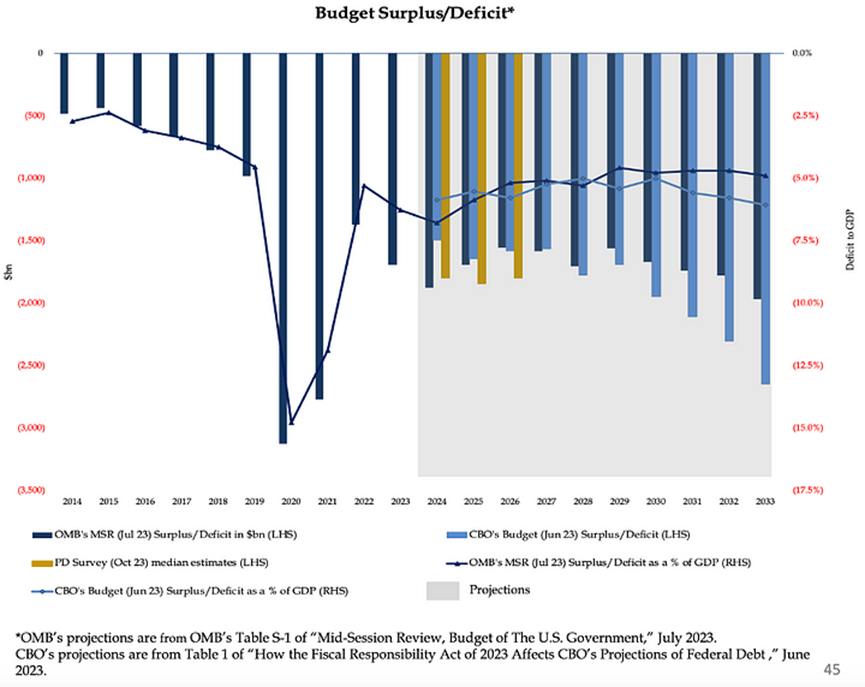
Short-term Treasuries
Yellen is not omnipotent. If she force-feeds the market with trillions of dollars in debt, bond prices will fall, and yields will rise. This will destroy any benefits the financial system gained from the Fed pausing rate hikes. Yellen needs to find a pool of funds that is very willing to buy a large amount of debt without demanding higher yields.
MMFs currently hold about $1 trillion in the Fed's RRP. This means MMF yields are close to the lower limit of the federal funds rate at 5.25%. The yields on 3-month and 6-month Treasury bills are around 5.6%. MMFs deposit funds with the Fed because the credit risk is low and funds can be accessed overnight. MMFs will not sacrifice too much yield to lower risk. But if Yellen can offer more Treasuries at slightly higher rates, money market funds will shift funds from low-yield fixed deposit rates (RRP) to higher-yield Treasuries.
In the latest quarterly financing report, Yellen pledged to increase the issuance of bills. One might argue that without $2 trillion in RRP, the sell-off of long-term Treasuries would be worse. Remember, back in early June, after U.S. politicians "shockingly" agreed to raise the U.S. debt ceiling, allowing them to spend more money, Yellen restarted borrowing. At that time, the RRP was $2.1 trillion. Since then, Yellen has sold a record amount of bills, and the RRP balance has halved since then.
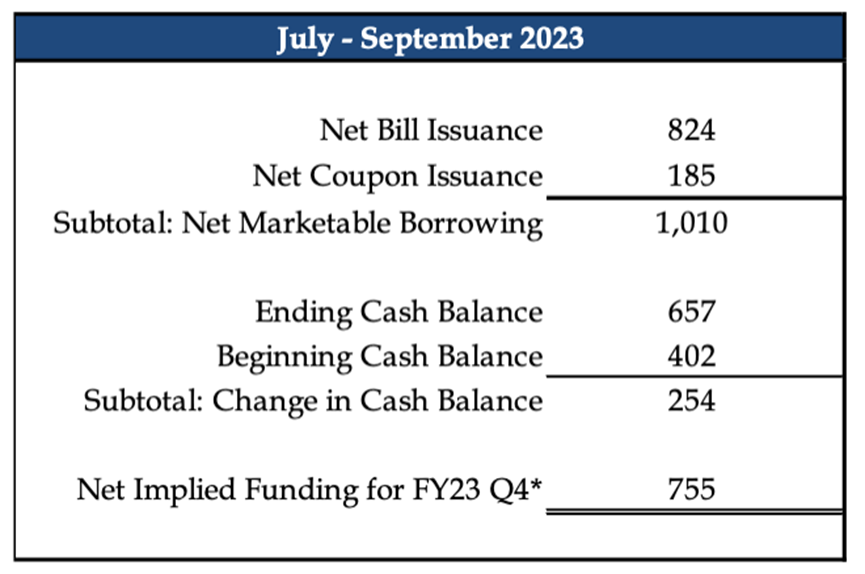
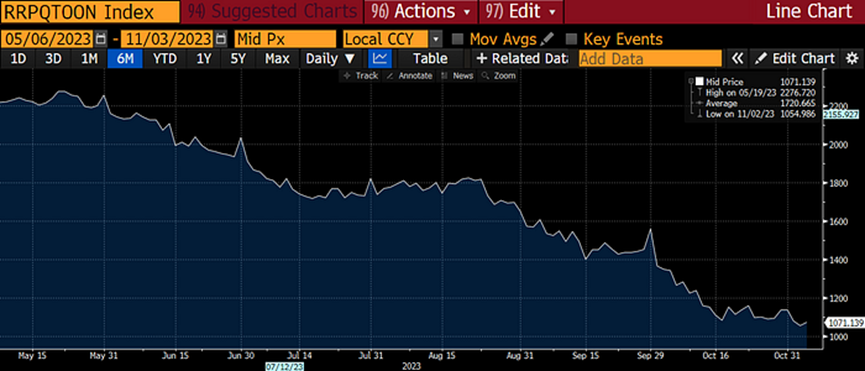
Yellen issued $824 billion in bills, and the RRP decreased by $1 trillion. Success!
Please refer to my article on dollar liquidity "Teach Me Daddy" to fully understand why dollar liquidity rises when the RRP balance declines. It is important to note that if Yellen increases the Treasury General Account (TGA), it will offset the positive liquidity deficit caused by the decline in RRP balance. The TGA is currently about $820 billion, above the target of $750 billion. Therefore, I do not believe the TGA will rise from now on—instead, I think it may remain stable or decline.
As the RRP is exhausted, $1 trillion of liquidity will be released into the global financial markets. It may take six months to fully exhaust this facility. This estimate is based on the speed at which RRP has decreased from $2 trillion to $1 trillion and the projected pace of bond issuance.
Before I continue discussing how this funding will enter the cryptocurrency market, let me briefly outline how other central banks might respond.
Weak Dollar
As more dollars flow into the system, the dollar's price relative to other currencies should decline. This is good news for Japan, China, and Europe. These countries all face fiscal issues. They take different forms, but ultimately need to print money to support certain parts of their financial systems and government bond markets. However, not all central banks are created equal. Because the PBOC, BOJ, and ECB do not issue a global reserve currency, there are limits to how much they can print before their currencies depreciate against the dollar. All these central banks have been hoping and praying for the Fed to ease monetary policy so they can do the same.
These central banks can also ease monetary policy because the Fed's policies will have the most significant impact due to the incredible amounts involved. This means that any printing actions by the PBOC, BOJ, and ECB will have a smaller relative impact than the Fed. When converted to currency, the renminbi (China), yen (Japan), and euro (Europe) will strengthen against the dollar. They can print money to save their banking systems and support their government bond markets. Ultimately, energy imports priced in dollars become cheaper. This contrasts sharply with recent situations where printing money led to their currencies depreciating against the dollar, which in turn increased the costs of energy imports priced in dollars.
The result is that while a large amount of dollar liquidity is injected, there will also be corresponding injections of renminbi, yen, and euros. From now until the first half of 2024, the total amount of available fiat credit globally will accelerate in growth.
Stupid and Smart Trades
Given all the liquidity of fiat currencies in the global market, what should people buy to outpace currency depreciation?
First, the dumbest thing one can do is to buy long-term bonds with a buy-and-hold mentality. As long as RRP > 0, this positive liquidity condition will persist. When RRP = 0, all the issues with long-term bonds will resurface. The last thing you want to do is to be unable to profit from any form of illiquid long-term debt when liquidity conditions change. Therefore, the dumbest manifestation of this trade is to buy long-term bonds, especially government bonds, and be mentally prepared to hold them. Today you will experience a market-to-market gain, but at some point, the market will begin to digest the impact of the further decline in RRP balance, and long-term bond yields will slowly rise, meaning prices will fall. If you are not a skilled trader, you will smash your golden egg with your diamond hands.
A moderately smart trade is to go long on short-term debt with leverage. Macro trading god Stan Druckenmiller recently told the world in an interview with Robinhood about fellow god Paul Tudor Jones that he bought ultra-long 2-year Treasuries. Great trade, brother! Not everyone is interested in the best expression of this trade (hint: it's cryptocurrency). Therefore, if all you can trade are manipulated TradFi assets like government bonds and stocks, then this is a decent choice.
A trade slightly better than moderately smart (but still not the smartest trade) is to go long on large tech companies, especially those related to artificial intelligence (AI). Everyone knows AI is the future. This means anything related to AI will thrive because everyone is buying it. Tech stocks are long-term assets that will benefit as cash becomes garbage again.
As I mentioned above, the smartest trade is to go long on cryptocurrencies. Nothing outpaces the growth of central bank balance sheets like cryptocurrencies.
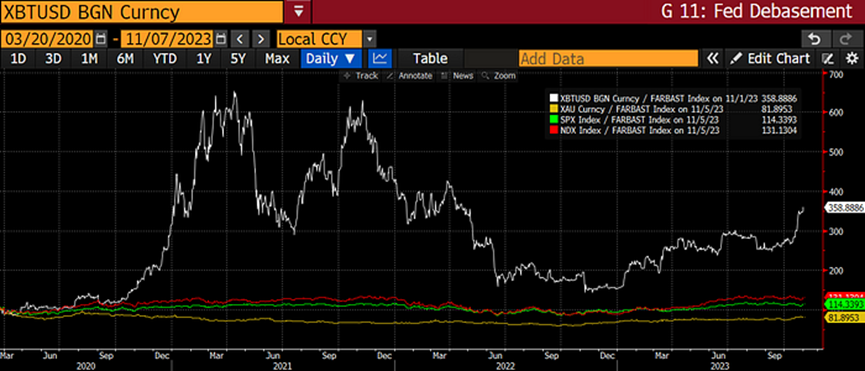
This is a chart of Bitcoin (white), the Nasdaq 100 index (red), the S&P 500 index (green), and gold (yellow) divided by the Fed's balance sheet indexed to 100 since March 2020. As you can see, Bitcoin has outperformed all other assets (+258%) under the influence of the Fed's balance sheet expansion.
The first stop is always Bitcoin. Bitcoin is money, and just money.
The next stop is Ethereum. Ethereum is the commodity powering the Ethereum network, the best internet computer.
Bitcoin and Ether are the reserve assets of cryptocurrencies. Everything else is junk coins.
Then we move on to other first-layer blockchains that claim to improve upon Ethereum. Solana is one example. These have been beaten down badly during the bear market. Therefore, they will rise from extremely low prices, offering huge returns for brave investors. However, they are still overhyped and cannot surpass Ethereum in terms of active developers, dApp activity, or total value locked.
Finally, various dApps and their respective tokens will launch. This is the most exciting part because this is where you get 10,000x returns. Of course, you are also more likely to get wrecked, but there are no rewards without risks.
I love shitcoins, so don't call me a maxi!
The Road Ahead
I am closely monitoring the [RRP - TGA] network to determine if dollars are flowing into the market. This will dictate whether I accelerate the sale of Treasuries and the purchase of Bitcoin, as my confidence grows with the expectation of increased dollar liquidity. But I will remain agile and flexible. The best-laid plans of mice and men often go awry.
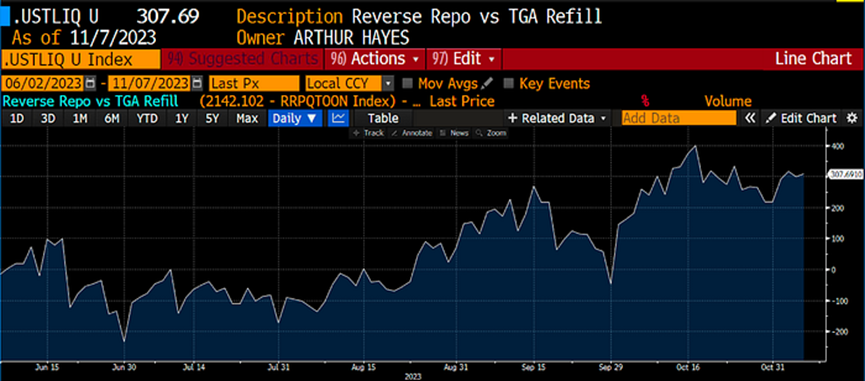
Since Yellen was allowed to borrow again in June 2023, the Fed has net injected $300 billion. This is a combination of the decrease in RRP and the increase in TGA.
The ultimate uncertainty is oil prices and the war between Hamas and Israel. If Iran gets drawn into the war, we should consider that oil supplies flowing to the over-leveraged West will be disrupted. This would make it politically difficult for the Fed to adopt a non-interventionist monetary policy. They may have to raise rates to combat higher oil prices. On the other hand, one might argue that due to the war and rising energy prices, the economy will enter a recession, which would give the Fed a license to cut rates. In either case, uncertainty will rise, and the initial reaction may be a sell-off in Bitcoin. As we have seen, Bitcoin has proven to perform better than bonds during wartime. Even with a weak initial phase, I will buy the dips.
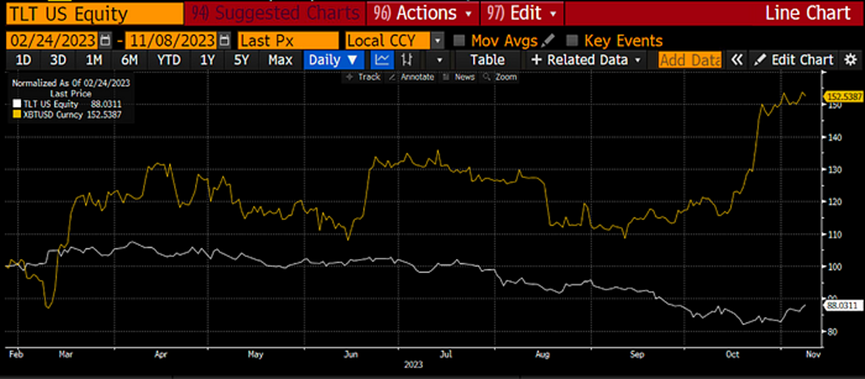
Since the outbreak of the Ukraine/Russia war, U.S. long-term Treasury ETFs (TLT) have fallen by 12%, while Bitcoin has risen by 52%.
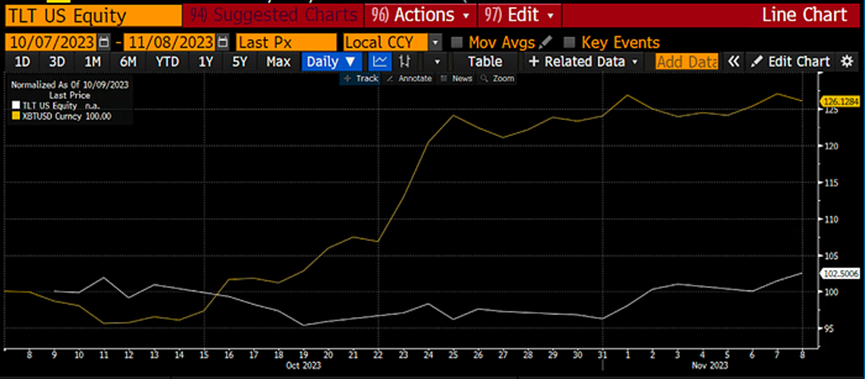
Since the outbreak of the Hamas/Israel war, TLT has risen by 3%, while Bitcoin has risen by 26%.
If lowering the RRP is bad girl Yellen's goal, then it will only last so long. All the concerns in the U.S. Treasury market will return, concerns that previously caused U.S. Treasury yields to soar in a bearish manner in 2010 and 2030, putting pressure on the financial system. Yellen has yet to convince her baby daddy to stop drinking, so after the calm, Bitcoin will once again become a real-time scoreboard of the health of the wartime fiat financial system.
Of course, if those responsible for "peace under America" were committed to peace and global harmony, I wouldn't even intend to finish this thought. These mofos have been waging wars since 1776, with no signs of stopping.











